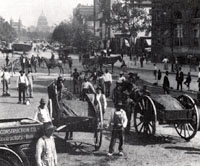History of Asphalt Form Begin up to now!
The History of Asphalt
 The
story of asphalt begins thousands of years before the founding of the United
States. Asphalt occurs naturally in both asphalt lakes and in rock asphalt (a
mixture of sand, limestone and asphalt).
The
story of asphalt begins thousands of years before the founding of the United
States. Asphalt occurs naturally in both asphalt lakes and in rock asphalt (a
mixture of sand, limestone and asphalt).
The ancient Mesopotamians used it to waterproof temple baths and water tanks.
The Phoenicians caulked the seams of their merchant ships with asphalt. In the
days of the Pharaohs, Egyptians used the material as mortar for rocks laid along
the banks of the Nile to prevent erosion, and the infant Moses' basket was
waterproofed with asphalt.
625 B.C.
The first recorded use of asphalt as a road-building material in Babylon. The
ancient Greeks were also familiar with asphalt. The word asphalt comes from the
Greek "asphaltos," meaning "secure." The Romans used it to seal their baths,
reservoirs and aqueducts.
1595
Europeans exploring the New World discovered natural deposits of asphalt. Sir
Walter Raleigh described a "plain" (or lake) of asphalt on the island of
Trinidad, near Venezuela. He used it for re-caulking his ships.
Early 1800s
Thomas Telford built more than 900 miles of roads in Scotland, perfecting the
method of building roads with broken stones. His contemporary, John Loudon
Macadam, used broken stone joined to form a hard surface to build a Scottish
turnpike. Later, to reduce dust and maintenance, builders used hot tar to bond
the broken stones together, producing "tar macadam" pavements.
1870
Belgian chemist Edmund J. DeSmedt laid the first true asphalt pavement
in the U.S. in Newark, N.J. DeSmedt also paved Pennsylvania Avenue in
Washington, D.C. – using 54,000 square yards of sheet asphalt from Trinidad
Lake. The Cumber Company opened the first central hot mix production facilities
in the U.S. The first asphalt patent was filed by Nathan B. Abbott of Brooklyn,
N.Y. in 1871.
1900
Frederick J. Warren filed a patent for "Bitulithic" pavement, a mixture of
bitumen and aggregate ("bitu" from "bitumen" and "lithic" from "lithos," the
Greek word for rock). The first modern asphalt facility was built in 1901 by
Warren Brothers in East Cambridge, Mass.
1907
Production of refined petroleum asphalt outstripped the use of natural asphalt.
As automobiles grew in popularity, the demand for more and better roads led to
innovations in both producing and laying asphalt. Steps toward mechanization
included drum mixers and Portland cement concrete mechanical spreaders for the
first machine-laid asphalt.
1942
During World War II, asphalt technology greatly improved, spurred by the need of
military aircraft for surfaces that could stand up to heavier loads.
1955
The National Bituminous Concrete Association (forerunner of the National Asphalt
Pavement Association or NAPA) was founded. One of the first activities: a
Quality Improvement Program, which sponsored asphalt testing at universities and
private testing labs.
1956
Congress passed the Interstate Highways Act, allotting $51 billion to
the states for road construction. Contractors needed bigger and better
equipment. Innovations since then include electronic leveling controls,
extra-wide finishers for paving two lanes at once and vibratory steel-wheel
rollers.
1970s
The national energy crisis underscored the need for conservation of natural
resources. Since that time, an increasing amount of recycled asphalt has been
incorporated in mixes. Today, asphalt pavement is America's most recycled
material with more than 70 million metric tons of asphalt paving material is
recycled each year.
1986
NAPA established the National Center for Asphalt Technology (NCAT) at Auburn
University, Alabama, providing a centralized, systematic approach to asphalt
research. NCAT recently opened a new research center and test track and is now
the world's leading institution for asphalt pavement research.
2002
The EPA announced that asphalt plants are no longer on its list of industries
considered major sources of hazardous air pollutants.
[back to top of page]
 The
story of asphalt begins thousands of years before the founding of the United
States. Asphalt occurs naturally in both asphalt lakes and in rock asphalt (a
mixture of sand, limestone and asphalt).
The
story of asphalt begins thousands of years before the founding of the United
States. Asphalt occurs naturally in both asphalt lakes and in rock asphalt (a
mixture of sand, limestone and asphalt).